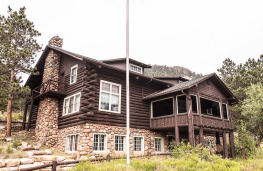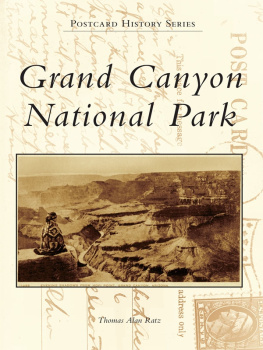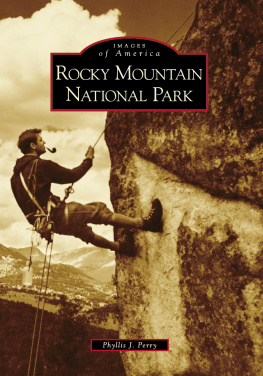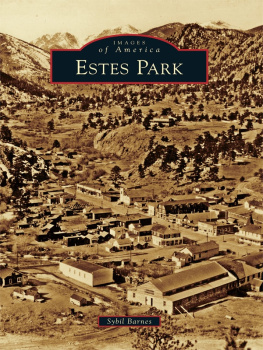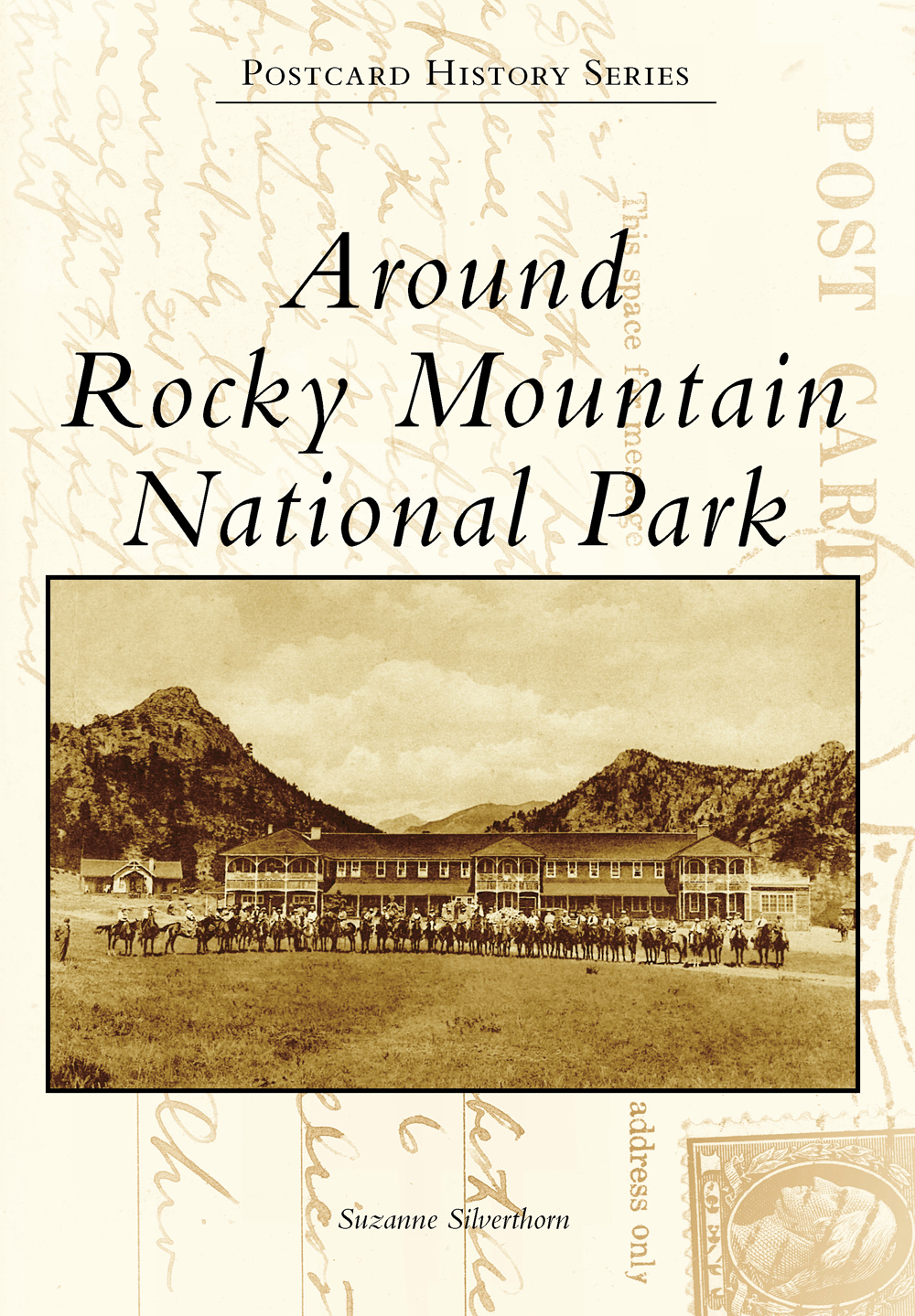
POSTCARD HISTORY SERIES
Around
Rocky Mountain
National Park

This W.T. Parke postcard was used to promote the relative ease to reach Estes Park from any number of locations. Drawn by Dean Babcock, the map was created prior to establishment of Rocky Mountain National Park in 1915 and shows the proposed location of the transcontinental route, Fall River Road, which was completed in 1920. The back of the card proclaims, Estes Parkthe Playground of Colorado. Best Auto Roads in the State. Try it Once. (Courtesy Bobbie Heisterkamp Collection.)
ON THE FRONT COVER: Guests gather in front of the Elkhorn Lodge on saddle horses provided by the lodge in a c. 1910 postcard by F.P. Clatworthy. The property included a livery stable with access to numerous trails. (Author collection.)
ON THE BACK COVER: Sightseers enjoy a guided tour through Rocky Mountain National Park in open-air buses provided by the Rocky Mountain Parks Transportation Company in a postcard made by the H.H. Tammen Co. around 1921. At the first hint of spring, crews would spend a month or more clearing snow to prepare Fall River Road for its season opening. (Author collection.)
POSTCARD HISTORY SERIES
Around
Rocky Mountain
National Park
Suzanne Silverthorn

Copyright 2015 by Suzanne Silverthorn
ISBN 978-1-4671-3375-3
Ebook ISBN 9781439653036
Published by Arcadia Publishing
Charleston, South Carolina
Library of Congress Control Number: 2015945438
For all general information contact Arcadia Publishing at:
Telephone 843-853-2070
Fax 843-853-0044
E-mail
For customer service and orders:
Toll-Free 1-888-313-2665
Visit us on the Internet at www.arcadiapublishing.com
Dedicated to my mother, Dian Zillner, who introduced me to world of collecting and encouraged me to pursue my passion
CONTENTS
ACKNOWLEDGMENTS
It was only recently that I became aware of the lasting contributions of my former Grand Lake, Colorado, employersBill and Betty Caswell. As a teenager in the 1970s, while I was busy washing dishes and waiting tables at their Golden Spur restaurant, the Caswells were working on a legacy project to help create the Grand Lake Area Historical Society, which, along with the Grand County Historical Association, continues as an important resource to preserve the area history. Across the Continental Divide, the Estes Park Museum and its Friends and Foundation organization have been established as a similar repository. These organizations are supported by dedicated staff members and volunteers who work tirelessly to share their passion about local history and its relevancy. My thanks to many of these individuals who have taken the time to assist with questions and research, including Tim Nicklas, museum director for the Grand County Historical Association, and Kathy Means of the Grand Lake Area Historical Society, as well as Steve Batty, Don Campbell, and Jane Patience Kemp, whose families have been connected with Grand Lake for decades.
Another valuable resource has been the Estes Park Postcard Club, which is a wonderful outlet to meet like-minded collectors. One of its members is Bobbie Heisterkamp, who has acquired one of the largest known collections of Rocky Mountain National Parkarea postcards and has graciously loaned some of her favorite images for inclusion in this book. Bobbies collection is destined to be archived at the Estes Park Museum so that it might be used for research and exhibits and shared with generations to come.
My thanks are extended, also, for help provided by fellow Arcadia author and historian Sybil Barnes. Additional assistance was provided by Jim Detterline, who served as a Longs Peak Supervisory Climbing Ranger until 2009. Jim is an expert on Longs Peak history, having broken the all-time Longs Peak summit record in 2010 with 351 lifetime climbs, surpassing Shep Husteds long-standing record of 350. Special thanks also go to Kelly Cahill, curator of Rocky Mountain National Park.
Appreciation is also extended to Arcadias Stacia Bannerman for her editorial guidance and, of course, members of my family, who allowed me to give this project my undivided attention.
Every attempt is made to identify the publisher or photographer of each of the postcards used in this publication. All postcards containing a mark on the bottom right corner were produced by Sanborn unless noted otherwise. Most postcards are from the authors collection. Credits are given for images supplied by the Bobbie Heisterkamp Collection, Grand County Historical Association, and Fort Collins Local History Archive.
INTRODUCTION
Long before the nations 10th national park was established in the Rocky Mountains of Colorado, photographic images showing the rugged landscape of newly surveyed territories of the American West began circulating to settlements east of the Mississippi. The images from the mid- to late 1800s by William Henry Jackson and other skilled photographers were accompanied by first-hand accounts of adventure, opportunity, and an abundance of gold and silver.
While Colorados mining boom was short-lived, many of the prospectors that had come seeking new fortunes settled into other pursuits. Among the early inhabitants was Joel Estes, who built a cabin and raised cattle around 1859 near the present-day Estes Park, which was platted in 1905. The town, bordering Rocky Mountain National Park, is named in his honor. While Estess time in the area was brief, Griff Evans took over the property and found that providing food and housing for early explorers was a convenient way to supplement an elusive ranching income. In anticipation of accommodations needed for even more visitors, the Estes Park Hotel was opened in 1877, followed by other hostelries. Across the Continental Divide in Middle Park, former prospector Joseph Wescott arrived in 1867, eventually becoming Grand Lakes first postmaster. And so they came, creating a new presence on lands that had once served as tribal hunting grounds for the Ute, Arapaho, and Cheyenne.
In the 1870s, even more gritty homesteaders arrived and claimed the land as their own, just in time for a surge of wealthy sightseers made possible by the railroads. On the east side of the Continental Divide, rail lines that had been laid in the late 1870s allowed the Colorado and Southern Railway to provide passenger service to the nearby communities of Loveland and Longmont. On the west, the Denver Northwestern & Pacific Railroad was delivering passengers as far as Granby by 1905, while Denvers Union Station became a hub for the major railroads. The possibility of bringing a rail line through the future Rocky Mountain National Park was contemplated as early as the 1880s, when a route was surveyed by the Greeley, Salt Lake & Pacific Railroad. However, the route never materialized due to the engineering and economic difficulties. Roads, therefore, became the great connectors to funnel tourists from the rails to the mountainsides. Transportation pioneers, most notably David Osborn, Freelan Oscar Stanley, Edward L. Berthoud, and Roe Emery provided significant investment in the creation of roads and other infrastructure to make way for the tourists.
The hospitality industry began to hit its stride on the east side of the Continental Divide when F.O. Stanley opened the Stanley Hotel in Estes Park in 1909. The hotel provided a critical transportation link in its use of Stanley Steamer automobiles along narrow wagon roads to connect guests with the train depots. By now, other nearby lodges had been established with proprietors at the Estes Park Hotel, Steads Hotel, Elkhorn Lodge, Rustic Hotel, and other lodges welcoming loyal customers that would return in ensuing years.
Next page

